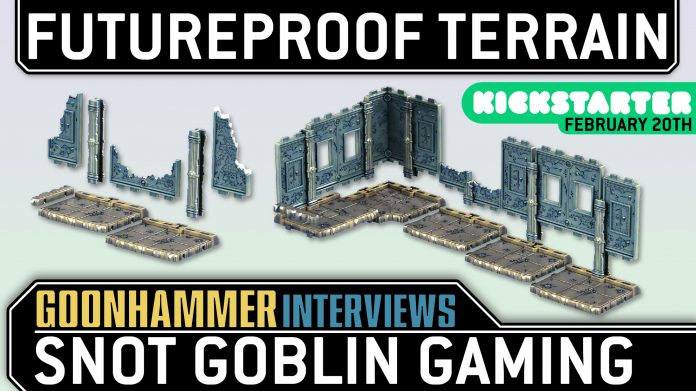Terrain, like milk, does the body good. That is, assuming your body is a tabletop wargame, and I’ve painted enough Admech that I’m probably half Nuln Oil by volume from sheer osmosis at this point. I’ve become one with the paint. Or one-half, I suppose. I’m not sure where I’m going with this metaphor, but I am sure where I’m sitting.
Down. Sitting down, that is, I’m sitting down with Michael Meguire from Snot Goblin Gaming to talk about his upcoming line of terrain, FutureProof Terrain, launching on Kickstarter on February 20th. The astute among you may remember we talked about the first iteration of Snot Goblin Gaming’s terrain in our review all the way back in August 2022. We had some criticism with it, but overall it was and is a pretty great set of terrain that got the Goonhammer stamp of approval. And this new line of terrain looks to have seriously stepped up its game.
FutureProof Terrain assembly. Credit: Snot Goblin Gaming
So with further ado, and with an inexplicable Speed reference, let’s sit down with Michael from Snot Goblin Gaming and talk about terrain.
This interview is sponsored by Snot Goblin Gaming, but we ain’t lying when we say we’re excited about this terrain!
Pendulin, Goonhammer: Pop quiz, hotshot. There’s a wargaming enthusiast on a bus. Once the gamer plays 50 seconds on crummy terrain, the gamer blows up. If they don’t hear your pitch for better terrain in 50 seconds, the bus blows up. What do you do? What do you do?
Michael, Snot Goblin Gaming: Oh, man, you guys are in trouble; I could talk about this all day. But I guess it’s worth trying to cut it short. The shortest pitch? It’s like LEGO, but for wargaming. I made a list of all the things I can’t stand about the various terrain options (too hard to get it exactly right for symmetric layouts, too big, too fragile, too expensive, too vulnerable to rules changes, too repetitive) and I thought, “someone, somewhere, must have a solution for this.” Whelp, I couldn’t find one. So I made one. This is it. (Was that 50 seconds? Is everyone OK?)
Pendulin: Looks like the bus is fine, which means we can put away our references to a *looking up Speed on IMDB* THIRTY YEAR OLD MOVIE. While my bones slowly crumble to ash, let’s talk about you and where this all started.
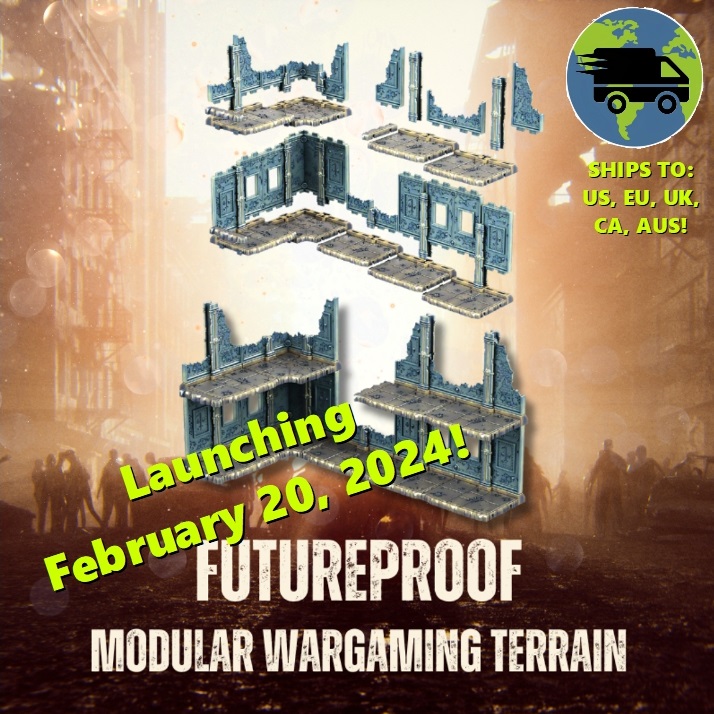
Thanks for joining me today, by the way, and before we dive into the “what” of this terrain, let’s cover the simpler (and more philosophically terrifying) question of “who”. Who are you? Who am I? Who are any of us? What does this all mean? I’m sorry, I didn’t mean to slip a “what” in there. I’m still stuck on Speed being thirty years old.
Getting back on track, who are you and what made you interested in terrain?
Snot Goblin Gaming: Geez, Speed is 30?! I genuinely thought that was still a topical reference. Who am I? Well, that’s, uh, a very long story. The short version is that I’m a former Green Beret, combat veteran, entrepreneur, law student, and–most importantly–a Warhammer enthusiast.
I got back into the hobby in 2019 (after dropping it as a 15-year-old, as one does, when I realized that my disposable income was no match for GW prices.) It started with beerhammer, with terrain made from cereal boxes and bricks and what-have-you, then progressed to basementhammer, where I actually cobbled together some functional WTC terrain from plywood. The better I got, and the more competitive the games became, I felt like I outgrew my homemade setup; so I decided to buy terrain.
Well, that was just incredibly frustrating. Everything was either 1) purely aesthetic and made by people who clearly didn’t know or didn’t care about the actual rules, 2) purely functional, with the dimensional accuracy I was looking for but made out of … foam? Blank cardboard? Woof. Or, 3) expensive, bespoke sets that catered to one tournament circuit’s layout and would become largely useless in 6 months when the terrain rules changed.
I knew exactly what I wanted, but nobody was making it. So, hell, I figured I’d just go ahead and do it myself.
Pendulin: I can respect that, and that’s honestly one of the big reasons Goonhammer exists. We were disappointed by the number and quality of HOT DOG LUNCH and BOAT STUCK jokes on the internet, and decided to do it ourselves. Also wargaming played a role, but it was mostly jokes about deli meats and Gregbot.
For your first dive into making terrain, we had a lot of good things to say about it in our review, but we also had a fair amount of criticism. What did you learn from the first version, and how has that impacted your design and production of FutureProof?
Snot Goblin Gaming: I appreciate you guys doing that review, and not pulling any punches. I could fill a book–at least–with what I learned from the first version (which still doesn’t even have a name, what was I thinking??) I think, mainly, I learned that the product I wanted didn’t exist because it’s freaking hard to make. But I won’t bore you with the production side of things.

The biggest takeaway was to not compromise the main vision. The first version was modular and, if you squint really hard, functioned basically the same as FutureProof terrain. However, I let the engineer talk me into using fiddly connectors and caps, and I made the decision to basically completely forego aesthetics. I was on a tight budget. I didn’t know if anyone else even wanted the thing, let alone if they’d pay me for it.
Pendulin: As an engineer, let me assure you that we’re all lying. It doesn’t take a full sprint to ack user feedback, the monitoring was in place and we simply ignored it, and nobody needs to “circle back” to anything ever.
But let’s circle back to monitoring your user feedback, and how that impacted your designs.
Snot Goblin Gaming: Turns out, there’s actually a pretty big segment of people who have the same problems with terrain that I do. This time, I found different engineers, different designers. I streamlined the entire assembly, so you can pick it up and go without needing any instructions. I hired a (very) patient CAD engineer, who painstakingly hand-sculpted a bunch of gothic details in SolidWorks (which, I found out, is much, much harder than just throwing together an .STL on blender. In order for it to produce an injection mold, you can’t use polygons.)
Pendulin: There are few things that make me feel more incompetent than trying to do something simple in Blender, so I understand that pain. I modeled a Thunderhammer and arm for fun a couple months back, and it took me a solid couple days of work for it to look halfway decent. The work involved in modeling an entire table of terrain is beyond me.
And speaking of Thunderhammers, Warhammer dominates the tabletop wargaming scene and is a huge influence on the shape of the hobby. And the shape of that, especially in the current 10th edition, is based on using a balanced, competitive battlefield. What does that look like with FutureProof terrain?
Snot Goblin Gaming: As I mentioned above, that was actually one of the driving forces behind its creation. For example, pretty much all terrain across the major tournament circuits, and in Games Workshop’s GT manuals, have L-shaped ruins with sides that are pretty close to being divisible by chunks of 3 inches: 6×12″, 6×9″, 4×6″ (I said close), etc. Occasionally you see other ruin sizes, and those almost always have walls in multiples of 1-2 inches.
So, FutureProof terrain is designed with this in mind. Each wall segment in FutureProof is 3″ in length, and can be extended in increments of 1.5″. Combining these means you can build ruins for major events, GT missions, or Rule of Cool. I don’t think 90-degree angle ruins will ever go out of style, and you can make I, L, U, or even full square ruins with no issues.
Competitive battlefields with FutureProof Terrain. Credit: Snot Goblin Gaming
Pendulin: Right-angle buildings will always be around, regardless of the lies Dries Kreijkamp would tell. That’s right, I’m calling you out, 40 years and half the world away, you and your Bolwongingen sphere houses.
When I think of constructing buildings, especially with right-angle pieces, my first thoughts land on LEGO. You mentioned that earlier, and it gets the idea across quite well. But the mechanics on how FutureProof components fit in together is distinct from LEGO and rather unique: walls sliding into place, floors stacking on columns stacking on floors. Further, it’s quite different from how pieces fit together in your last version, which used a sort of hook and latch system.
What went into the design of this new connection system, and what design opportunities were opened for you by changing these connections?
Snot Goblin Gaming: I touched on this a bit earlier, because that hook and latch thing was a pain, and a little confusing for users. This time around, my mantra was “no instructions necessary.” If I have to make a YouTube video explaining which way to hold piece X, so that you can insert piece Y sideways into piece Z, then something is wrong.
This time, everything works exactly how you’d expect. Male tabs have an obvious shape that matches the female recesses. They fit together exactly how you’d think they do from looking at a picture. Everything is reversible on basically every axis; which is great for intuitive assembly and for varying the look of the finished buildings.
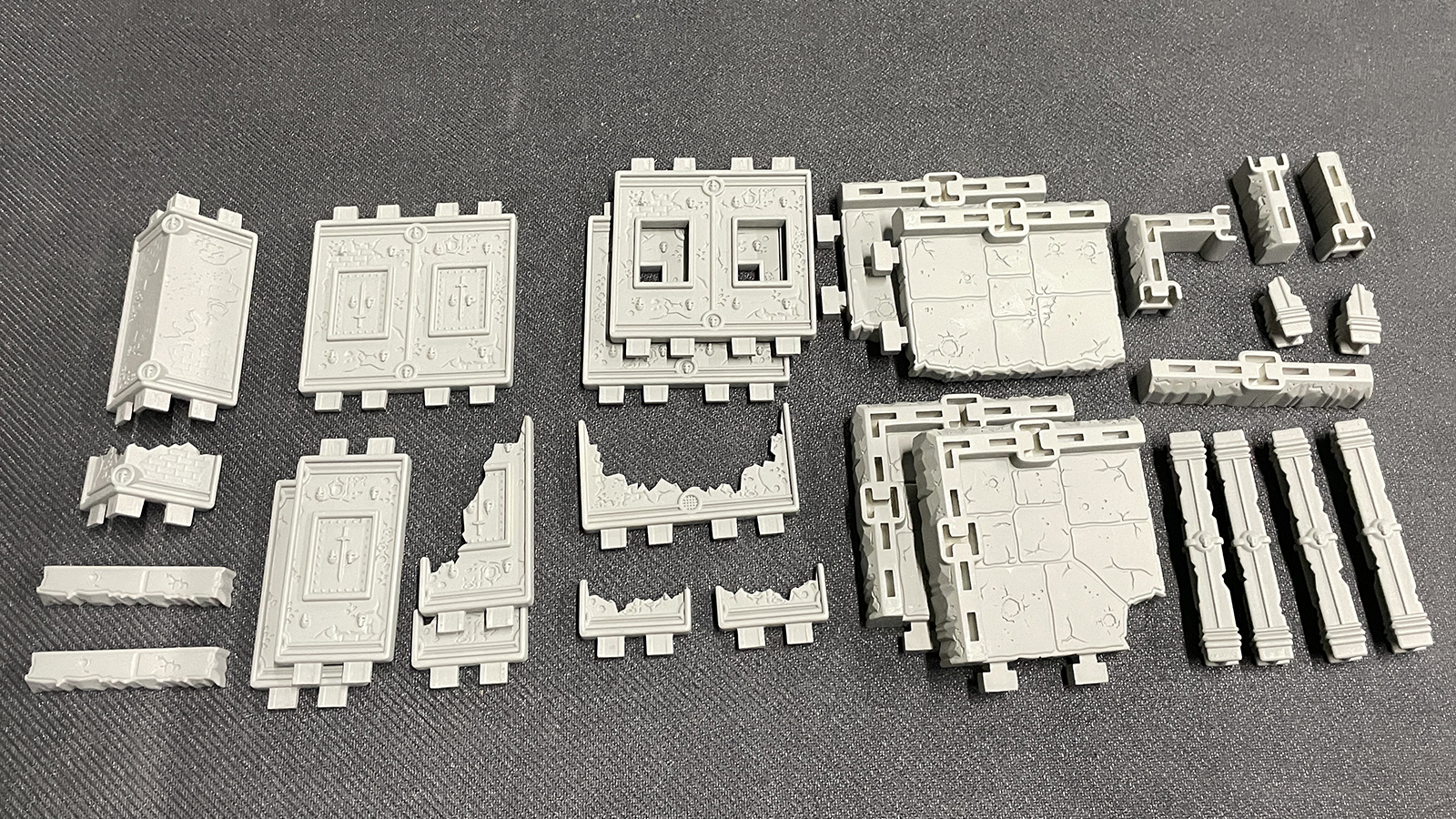
I genuinely think you could give these pieces to a kid, and they’d be rolling cover saves in about ten minutes.
Pendulin: I feel personally attacked. Kids are out there rolling saves, while my Adeptus Mechanicus don’t really get to “roll saves” and instead “just die” and “make me sad”.
I definitely appreciate the “no instructions” mindset, as most people don’t want to stop in the middle of setting up a battlefield to grab a PDF or watch a tutorial. Of all the changes from the first version, I think the floor components have gotten the biggest glow-up. These look completely different, are significantly thicker than before, and frankly look a lot better. What’s the reason for this change?
Snot Goblin Gaming: There are a couple reasons, actually! One is easy; it was just a functional necessity in order to have a nice foundation for the push-fit system and allow for verticality. The thicker floors also give a lot more options for aesthetic detail, which is a huge plus (I’m excited to really explore this option in future expansions). Finally, it allows for a hollow underside, instead of one flat surface. This means that it sits better on the table and has a much nicer balance, since there are fewer contact points.
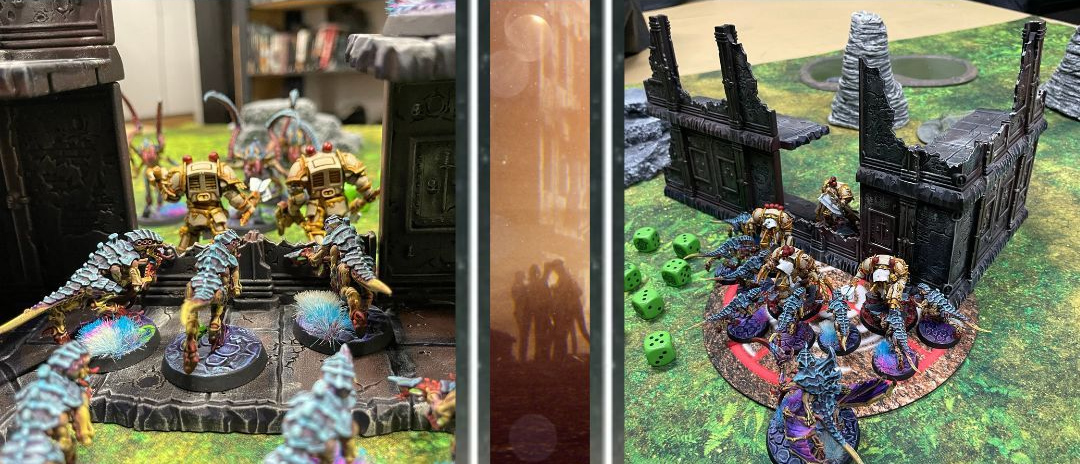
Pendulin: Expansions? I will straight up bribe you to get a Goonhammer-themed expansion. I don’t even know what that really means. Gregbot under the floor? Hubcaps from a Toyota Celsior? A poster that just says BOAT STUCK? Maybe walls modeled to look like the inside of the 2525 bus running downtown from Venice at 50 miles-per-hour and DAMMIT how is Speed thirty years old?
But a Goonhammer expansion would definitely be fun.
Snot Goblin Gaming: I genuinely can’t speak highly enough of Goonhammer’s site and contributors! You let me know, and I’ll try to make it happen. A Pendulin-relief carving on a full size wall!
Pendulin: A wall-sized carving of this mug? We’re truly in the grim-darkness of the 41st millennium, aren’t we?
My mug aside, the walls in FutureProof have received some great aesthetic improvements, now with cracked and exposed brickwork, proper windows and shutters, and the obligatory skull decorations of tabletop wargaming. Having these details on a modular terrain system opens the door for all sorts of customization, which is pretty exciting. What can we expect in terms of build variation – this is my L-Ruin, there are many like it, but how can I make mine unique?
Snot Goblin Gaming: The aesthetic detailing was much, much harder than I expected–so I tried to keep it relatively simple and setting-agnostic for the first release of FutureProof Terrain. The walls are different on each side, and can be flipped up or down, to further the variation.
Making a ruin your own is limited more by your creativity than the design – there are enough different types of components that you can make really unique-looking structures: half-width walls, half-height walls, half-width/height walls, half-width quarter-height walls, full-width full-height walls with windows, without windows … you get the point. They can be built to any height and any length, so long as you have enough pieces! I’m actually really excited to see what people come up with. Even with the first version, which was a lot less flexible, people were assembling it in ways that I never even considered! It was really cool!
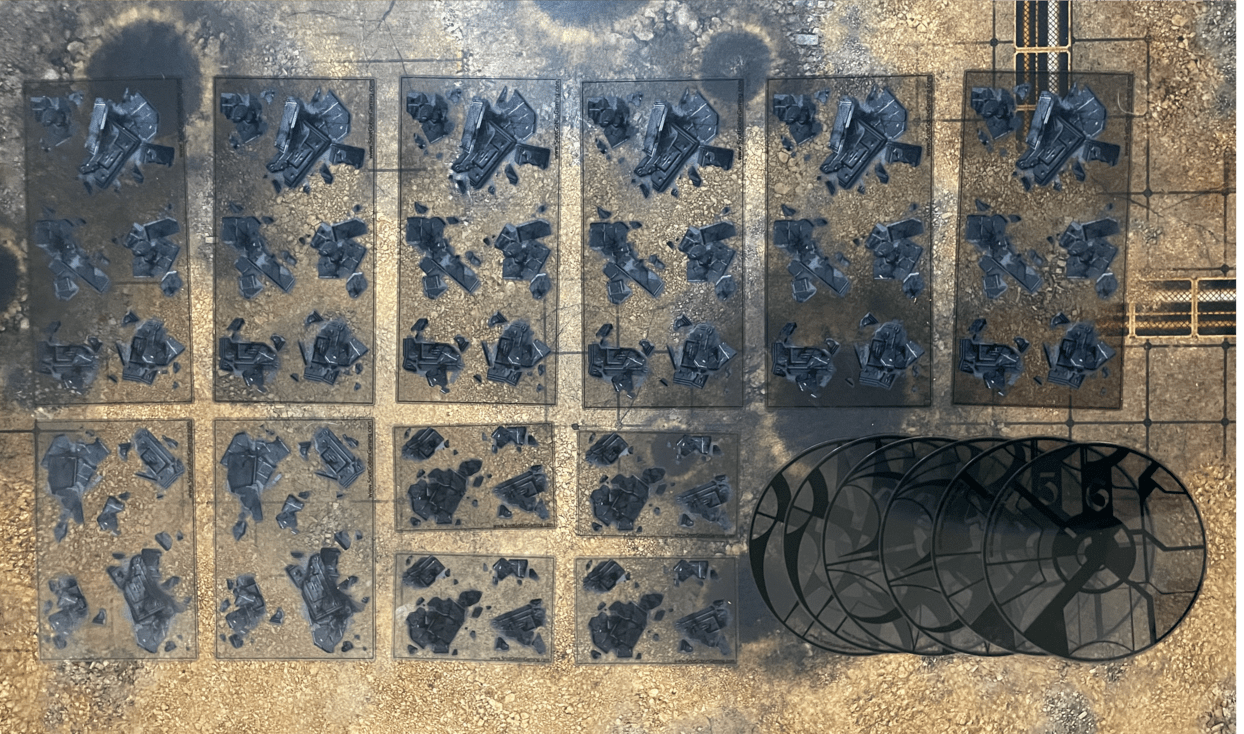
In addition to that, I’m already working on designing expansions. There will be two types: faction-specific, aesthetic expansions that use the same pieces with different looks; and functional expansions that have new pieces, like T-intersections, doors, and ramps. As a stretch goal, I hope to be able to offer a Chaos and a Definitely-Not-Tyranids alien-infected aesthetic expansion!
Pendulin: I’m hype-ramped for ramps. Like, unironically. Anything that bridges Z-levels in terrain goes a long way in making it feel dynamic and exciting.
And if our dear readers are feeling the hype too, your Kickstarter is launching on February 20th. For everyone looking forward to it, how can they sign up to get updates?
Snot Goblin Gaming: Absolutely! Readers can check out http://get.snotgoblingaming.com/20 for the landing page. It has product photos, renders, and more information. Signing up with an e-mail will get you updates, and you will be forwarded to a reservation page to sign-up as a VIP member for $1.
The $1 sign-up is really important, as it helps gauge how many sets I need to have in production when we go live. I want to ship orders as soon as possible – the molds are already made, and I want to get a head-start on production.
And, of course, there are perks! Signing up as a VIP member, you’re guaranteed a big discount: $100 off a Full Table Set and a free Single Ruin Add-On, or $60 off a Half Table Set. That brings the prices down to $199/$99, respectively.
VIPs will also have priority shipping on early production sets, as well as access to a private FaceBook page for early access to other discounts, discussion, and other goodies!
Pendulin: And as a sneak peak for our readers who made it all the way to the end of the interview, any hints for stretch goals of future plans?
Snot Goblin Gaming: I’ve got three kinds of stretch goals in the works right now.
The first, as I mentioned earlier, are demon-world and alien-world expansions. They’ll be offered as pre-release single-ruin packs that will be shipped to backers as soon as they’re ready! They won’t be available as whole sets until they’re more finalized, though.
Second, I am trying to work out a way to get painted sets at a reasonable price. This is a bit tricky, because nobody wants to paint 50,000 plastic walls, but I think it’s doable if it’s a relatively basic scheme. That would be available as an add-on upgrade.
Third, similar to the aesthetic expansion, would be an add-on for early access to a component expansion! This makes this already flexible design have even more versatility.
Pendulin: Awesome! Thanks for taking the time to talk with us and dealing with me barrelling through obscure references, just like a train barrelling through downtown Hollywood in the climactic finale of *sigh* 1994’s smash hit Speed.
Snot Goblin Gaming: Of course, thanks for taking the time to talk about my upcoming launch! And hopefully, I’ll be back…

That wraps up our chat with Michael from Snot Goblin Gaming about his upcoming FutureProof terrain. If you’re interested, then check it out and slap your email on the Launch Invites list. And if you’re champing at the bit to get it in your hands as early as possible, take a look at the VIP option for some pretty powerful savings.
